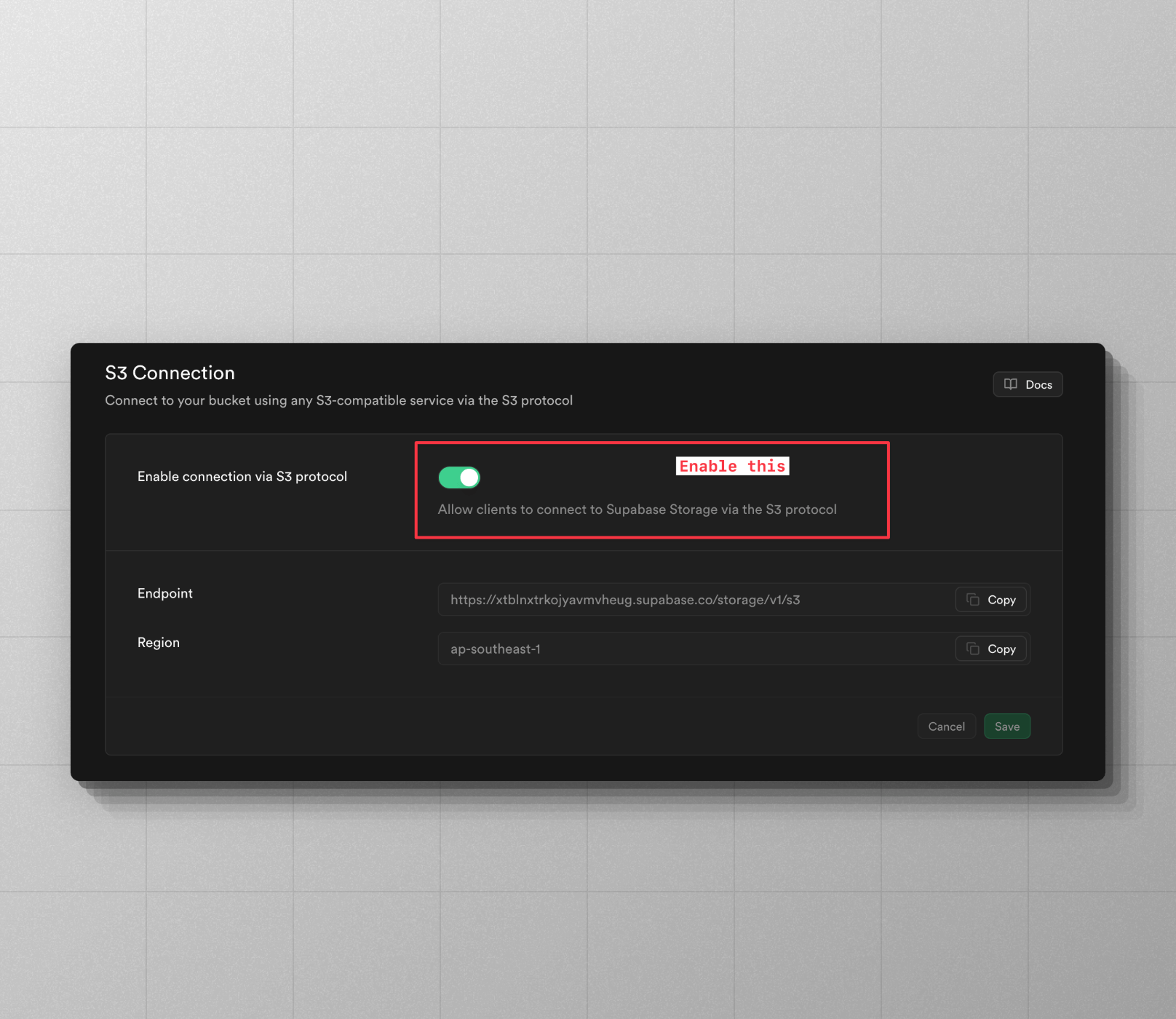Supabase Storage
Supabase Storage comes with an S3 compatibility layer. Therefore, you can use the S3Driver to manage files on Supabase. Make sure to install the following peer dependencies in your project.
npm i @aws-sdk/s3-request-presigner @aws-sdk/client-s3
Once done, you can create an instance of the S3 Driver and use it as follows.
import { Disk } from 'flydrive'
import { S3Driver } from 'flydrive/drivers/s3'
const disk = new Disk(
new S3Driver({
credentials: {
accessKeyId: 'SUPABASE_KEY',
secretAccessKey: 'SUPABASE_SECRET',
},
/**
* Copy and paste the endpoint and region from the "S3 Connection" settings
* section
*/
endpoint: 'https://xtblnxtrkioiavmvheug.supabase.co/storage/v1/s3',
region: 'ap-southeast-1',
supportsACL: false,
bucket: 'flydrive',
visibility: 'private',
})
)
You may pass all the options accepted by the @aws-sdk/client-s3 package to the S3Driver. However, the following options must always be defined when using Supabase.
-
supportsACL
-
Disable support for ACL. This is because Supabase does not support/implement ACL commands. As a result, the
disk.getVisibility()method will not perform an API call and return thevisibilityvalue from the config.Similarly, the
disk.setVisibility()method will result in aNOOP. -
endpoint
-
Always define the
endpointof your Supabase storage project. Grab theendpointfrom the S3 Connection settings section.
-
region
-
Specify the region for the superbase storage. You can grab the
regionfrom the S3 Connection settings section. -
bucket
-
The
bucketoption defines the Supabase bucket for managing files.
Creating public URLs
When creating the bucket on Supabase, mark it as public. Next, specify the bucket URL as the cdnUrl inside the service configuration. The cdnUrl must include the bucket name and have the trailing slash /.
const disk = new Disk(
new S3Driver({
cdnUrl: 'https://xtblnxtrkioiavmvheug.supabase.co/storage/v1/object/public/flydrive/',
endpoint: 'https://xtblnxtrkioiavmvheug.supabase.co/storage/v1/s3',
bucket: 'flydrive',
})
)
const URL = await disk.getUrl('avatar.png')
console.log(URL) // https://xtblnxtrkioiavmvheug.supabase.co/storage/v1/object/public/flydrive/avatar.png
You may also create a public URL by defining a custom URL builder within the config. For example:
const disk = new Disk(
new S3Driver({
bucket: 'flydrive',
endpoint: 'https://xtblnxtrkioiavmvheug.supabase.co/storage/v1/s3',
urlBuilder: {
async generateURL(key, bucket, s3Client) {
return `https://xtblnxtrkioiavmvheug.supabase.co/storage/v1/object/public/${bucket}/${key}`
},
},
})
)
const URL = await disk.getUrl('avatar.png')
console.log(URL) // https://xtblnxtrkioiavmvheug.supabase.co/storage/v1/object/public/flydrive/avatar.png
Creating signed URLs
Signed URLs are created to provide time-based access to a private file hosted on Supabase storage. For example:
const disk = new Disk(new S3Driver({}))
const signedURL = await disk.getSignedUrl('invoice.pdf', {
expiresIn: '30mins',
})
At the time of generating the signed URL, you can pass one of the following options along with the options accepted by GetObjectCommand class.
await disk.getSignedUrl('invoice.pdf', {
expiresIn: '30mins',
contentType: 'application/pdf',
contentDisposition: 'attachment',
/**
* Additional options applicable for S3 only
*/
ResponseCacheControl: 'max-age=604800',
})
Having issues?
Enable S3 compatibility mode
When using Supabase storage with FlyDrive, enable the S3 compatibility mode within the Supabase dasbhoard under project settings.

Define cdnUrl to publicly access files
To create public URLs, specify the cdnUrl pointing to your S3 bucket.
https://<project-id>.supabase.co/storage/v1/object/public/<bucket-name>/
Use the put method instead of putStream.
Many users have reported that the putStream method does not reliably work with Supabase, resulting in broken images. Therefore, you must use the put method instead of a stream to create the files.